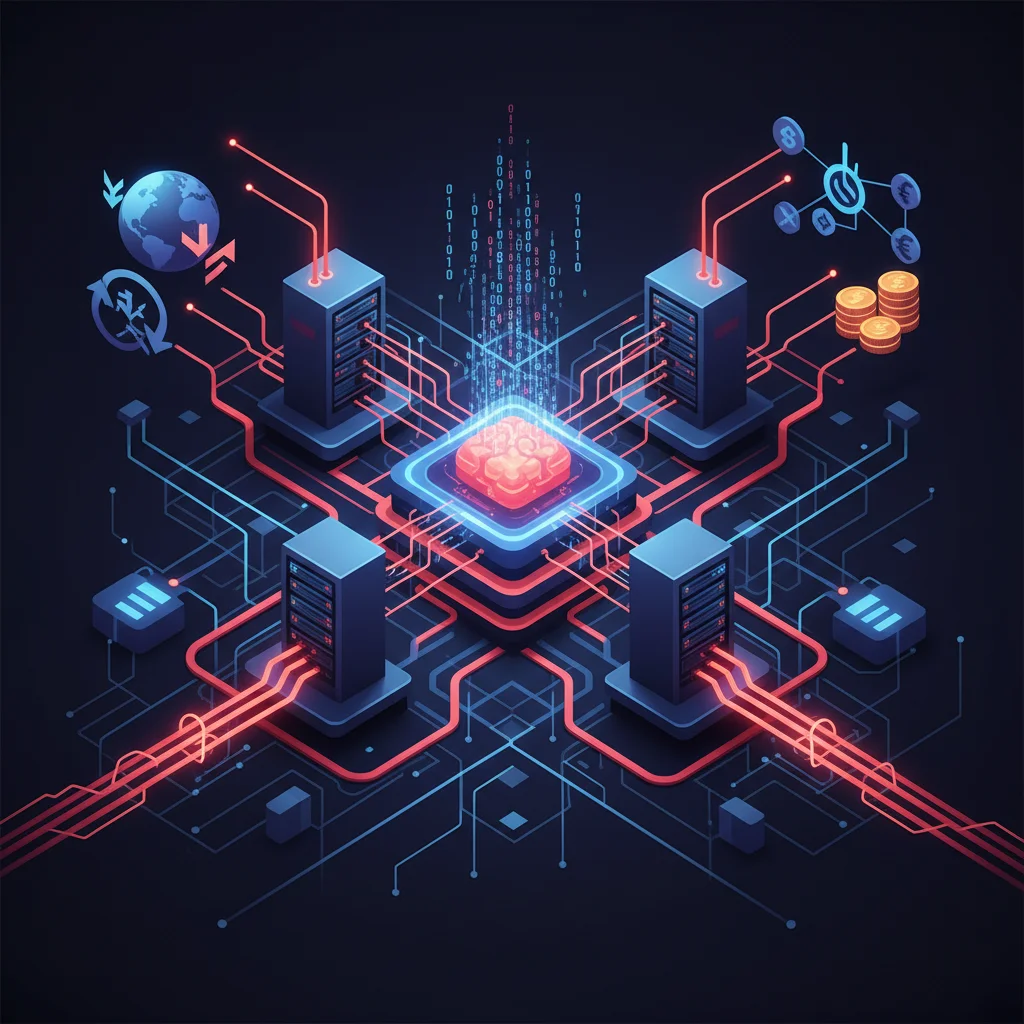
The AI Boom’s Dirty Secret: Your Code is Causing a Global Power Struggle
We are living in the golden age of artificial intelligence. With a few keystrokes, we can generate breathtaking art, debug complex code, and get answers to questions we haven’t even fully formed. This explosion of innovation, powered by sophisticated machine learning models and cloud platforms, feels limitless, magical, and purely digital. But behind the clean interface of your favorite AI tool lies a very real, very physical, and increasingly strained industrial world.
The software revolution is colliding with the laws of thermodynamics, and the fallout is just beginning. The insatiable energy appetite of modern AI is triggering a global scramble for a surprising piece of heavy machinery: the giant gas turbine. This isn’t just an industry footnote; it’s a looming crisis that threatens to bottleneck AI development, challenge our climate goals, and create a new front for geopolitical tension. The code we write in the cloud is having a direct, earth-shaking impact on the ground.
The Unquenchable Thirst of an AI Factory
To understand the problem, we first need to appreciate why artificial intelligence is so power-hungry. A simple Google search or a SaaS transaction uses a negligible amount of server power. But training and running a large language model (LLM) is a different beast entirely. It’s a brute-force computational marathon.
Think of it this way: traditional computing is like a library where a librarian fetches a specific book for you. It’s efficient and targeted. Generative AI is like asking that librarian to read the entire library and then write a new book in the style of Shakespeare. The sheer volume of processing—billions of parameters being calculated and recalculated across thousands of specialized GPU chips—generates an immense amount of energy demand and heat.
Data centers are no longer just data warehouses; they are AI factories. And these factories require a staggering amount of electricity. According to some estimates, the AI sector’s electricity consumption could grow to be comparable to the needs of entire countries like the Netherlands or Argentina within a few years. This isn’t a slow, predictable increase; it’s an exponential surge that our existing power grids were never designed to handle.
Caught in the Crossfire: How a US Ultimatum Sparked a Dutch Chipmaker Seizure
From Cloud Computing to Gas Combustion
So, where does this power come from? While the dream is to run everything on renewable energy like solar and wind, these sources are intermittent. The cloud needs to be on 24/7/356. A cloudy day can’t be allowed to crash a critical piece of software or interrupt an AI model’s training process. Nuclear power is a great source of baseload energy, but new plants take over a decade to build—a lifetime in the fast-moving world of tech innovation.
This leaves natural gas as the go-to solution. Gas-powered plants, using massive, jet-engine-like turbines, can be fired up quickly to provide reliable, on-demand electricity to stabilize the grid and meet sudden spikes in demand. They are the essential backup that makes the entire system work. As tech giants and startups race to build new AI-focused data centers, they are effectively placing massive, concentrated orders for new power capacity. And that has led them directly to the doors of a handful of companies that build gas turbines.
The result? A global supply crunch. The Financial Times reports that the demand for these behemoth machines is so high that wait times have ballooned, with some orders now taking up to a year longer than usual. This isn’t like a shortage of consumer electronics; the world’s supply of large-scale gas turbines is controlled by just a few industrial giants like GE, Siemens, and Mitsubishi. You can’t just spin up a new factory. This is a critical bottleneck connecting the world of code to the world of concrete and steel.
To put the scale of this shift into perspective, let’s compare the infrastructure needs of traditional data centers versus the new AI superclusters.
| Infrastructure Aspect | Traditional Cloud Data Center | AI Supercluster / “AI Factory” |
|---|---|---|
| Primary Workload | Web hosting, storage, SaaS applications, databases | Massive parallel processing for training and inference |
| Power Density | Low to Medium (5-15 kW per rack) | Extremely High (50-100+ kW per rack) |
| Energy Source Priority | Efficiency and cost, renewables where possible | Absolute reliability and massive scale (often requiring dedicated gas power) |
| Key Hardware | CPUs, standard servers, networking gear | Tens of thousands of high-end GPUs (e.g., Nvidia H100) |
| Grid Impact | Predictable, steady load | Massive, sudden demand spikes that can destabilize local grids |
The Global Ripple Effect of the AI Power Grab
This “dash for gas” isn’t happening in a vacuum. It has profound consequences that will ripple across the environment, geopolitics, and even cybersecurity.
1. The Environmental Setback
For years, the tech industry has been a vocal proponent of sustainability, with major players pledging to be carbon-neutral. However, this sudden, massive reliance on natural gas represents a significant step backward. While cleaner than coal, natural gas is still a fossil fuel that releases carbon dioxide. The urgency to power the AI boom is putting climate goals on the back burner, creating a direct conflict between technological progress and environmental responsibility. Projects that were slated to be powered by renewables are now being supplemented or replaced by gas, a trend that has alarmed environmental groups (source).
2. The Geopolitical Chessboard
Energy is geopolitics. Increasing the world’s reliance on natural gas inherently increases the influence of the nations that produce and export it. This can shift global power dynamics and create new dependencies at a time of increasing international instability. The race for AI dominance is no longer just about algorithms and talent; it’s now entangled with global energy markets and the complex relationships between nations.
3. The Cybersecurity Vulnerability
As we build out this new, highly centralized power infrastructure to support our cloud and AI services, we create high-value targets. A sophisticated cyberattack on the power plant feeding a major data center region could bring down essential services for millions. This tight coupling of the digital and physical worlds means that a threat to the energy grid is a direct threat to the cloud. Ensuring robust cybersecurity for this critical infrastructure is no longer an IT problem; it’s a matter of national and economic security.
The Billion Crypto Seizure: How AI and Cybersecurity Are Crushing Digital Crime Empires
The Path Forward: Innovation Through Constraint
This bottleneck, while challenging, is also a powerful catalyst for innovation. Scarcity forces creativity. The tech industry must now tackle the energy problem with the same fervor it applied to building AI models. The solutions will come from multiple domains:
- Smarter Software: The era of “computational waste” is over. Developers and data scientists will need to focus on algorithmic efficiency. Techniques like model quantization, pruning, and distillation, which create smaller, faster, and less power-hungry AI models, will become mainstream. Excellence in programming will be defined not just by performance, but by energy parsimony.
- Hardware and Cooling Innovation: The race is on to design more energy-efficient chips. Beyond that, new cooling technologies like liquid immersion cooling are becoming essential to manage the intense heat generated by AI hardware, reducing the overhead energy costs of data centers.
- Energy-Aware Automation: We can use AI to solve its own problem. Machine learning algorithms can be deployed to optimize data center energy use, predict grid loads, and intelligently schedule computational tasks during times of low energy cost or high renewable availability.
- Strategic Co-location: Startups and established players are exploring building data centers directly next to power sources, including small modular nuclear reactors (SMRs) and massive renewable farms, to create self-contained, resilient energy ecosystems.
–
For entrepreneurs and developers, this is a call to action. The next unicorn startup might not be one that builds a bigger LLM, but one that figures out how to run them for a fraction of the energy cost. The future of AI innovation depends on it.
Beyond the Rocket: How AI and Software Will Decide the New Space Race to Mars
Conclusion: The Real Cost of Intelligence
The artificial intelligence revolution is undeniably one of the most significant technological shifts in human history. But it is not happening in a vacuum. It is powered by a physical world of wires, generators, and now, a surprising shortage of gas turbines. The smooth, digital veneer of AI conceals a gritty, industrial reality that we can no longer afford to ignore.
This isn’t a story of doom, but a necessary reality check. The challenges of power and infrastructure are not roadblocks but guideposts, directing the future of innovation toward a more sustainable, efficient, and resilient path. The next great breakthrough in AI might not be a new algorithm, but a new paradigm—one that recognizes that true intelligence is not just about computational power, but also about the wisdom to manage it.


